DIAMONDS ARE A RIP OFF
ARE DIAMONDS REALLY A RIP OFF? FIND OUT...
This post contains affiliate links. If you use these links to buy something I may earn a commission. Thanks! As an Amazon Associate I also earn from qualifying purchases.
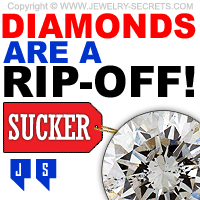
Diamonds really are a Rip Off!
After all, they are just another Rock from the Earth!
They are WAY too Expensive!
You don’t know what you’re Buying!
You Feel like Jewelers are Ripping you off!
You Spend all that Money on a Diamond that only Dulls up and Chips!
Not to Mention, the Resell Value is CRAP!
So Are Diamonds a Rip Off?
A lot of people think they are.
Let’s look at the Main Reasons why Diamonds are a Rip off and what I have to say about it…
- It’s just a Rock from the Earth
- The Same Exact Quality is Different Prices
- You Don’t Know what you’re Buying
- Grade Bumping!
- All Certs are Not Created Equal
- Diamonds Aren’t Forever
- Cut is Always Skipped over
- What’s Fluorescence?
- Multiple Colors & Clarity
- Approx. Carat Weights
- Inclusions GROW!
- The Appraisal and Retail is too High
- Diamond Warranty Void
- Return Policies
- Resell Value
That’s Quite a Long List of Rip Offs!
But what do they all mean, and are they Just?
Maybe, Maybe not!
Let’s take a closer look…
1) It’s just a Rock from the Earth
Really it is!
It’s a Rock Created in the Earth over a Billion years ago. So why did Diamonds become so Famous that we use it over any other Gemstone or Rock?
It’s Durability!
Diamond is the King of Gems because it’s 4x Harder than the next Most Hardest Natural Gem, which is Corundum, or Ruby & Sapphire!
Diamond’s Absolute Hardness is 1600, where as Corundum is just 400!
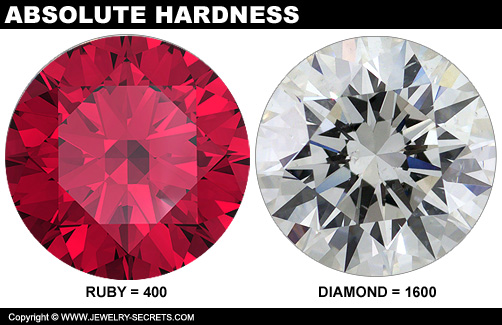
So it’s Harder than any other Gem. So what? Does this really make a Difference?
YES!
Because nothing else Natural is Harder, Nothing can Wear Diamond away (Except for another Diamond).
Diamonds won’t Erode or Scratch up like all the other Stones will. When they say Diamonds are Forever. They mean it!
Chances are that the Diamond you wear on your Finger today, will look Exactly like it does for another Billion years!
That’s Impressive!
Nothing else that you ever Buy in Life will last as long. It will certainly out live you.
Take the Price of a Diamond and Divide it up into a Whole Lifetime and see what it comes out to be… Pennies!
Look at how much you Spend on a Car that only lasts you Ten Years or so… If you’re Lucky!
That’s Money Spent and Gone, but your Diamond will still be here.
Diamond IS KING!
Diamond Demands the Price of Luxury. In fact, not too many years ago, Diamonds were Reserved for nothing but Royalty, Kings and Queens.
Don’t you Feel Special?
2) The Same Exact Quality is Different Prices
It’s True. A 1.00 Carat, SI1, G Diamond in one store may be $5,200, while that Same Exact Quality at another store may Sell for $7,000.
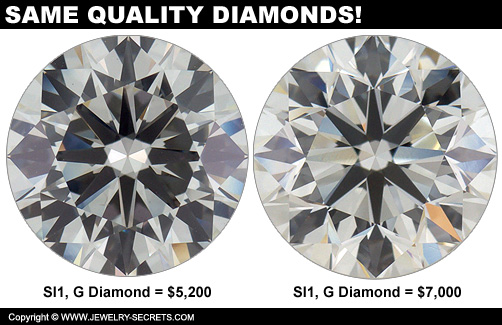
What Gives?
Shouldn’t all Diamonds of the same Clarity, Color and Cut be the Same Price?
NOPE!
Here’s why…
Every Diamond is Different!
Every Single Diamond has traits that no other Diamond in the World has. They are all Unique.
Diamonds are like People. They all have Different Features, Sizes, Shapes and Characteristics.
One of the Biggest Differences that separates Diamonds is CUT.
Cut can Affect the Price of a Stone Greatly. To the Naked Eye, a Stone may look Very Similar. But when you look at the Proportions, Symmetry and Percentages, you’ll see that Tiny, Minute Differences can Affect the Overall Beauty and Sparkle of the Stone.
Plus, there are many more Aspects about a Diamond that go into the actual Price. Not only Cut, Color, Clarity and Carat Weight, but things like: Measurements, Cutting Style, Shape, Culet Thickness, Girdle Thickness, Polish, Symmetry and Fluorescence.
They all Play a Role in what that Stone sells for.
You have to Compare EVERY Aspect in order to Understand why one Diamond is Priced much higher than another.
And, every Jeweler is different too. Some work on Lower Margins. Stores and Vendors buy and Sell Stones at Different Prices. The Price they get will usually Dictate what the Selling Price will be.
So if they get a Really Good Deal on a Diamond, they’ll usually Pass those Savings onto you.
But you have to be Careful!
Diamonds Sold Way Cheaper than other Similar Stones are usually Cheaper for a Reason!
The Cut (or Make) of the Stone may be off. It could have Strong Fluorescence (as we’ll get into later). It could also be Chipped!
You have to look at the Stone well. View it under 10x magnification so you can Scrutinize the inside and outside Surfaces. A Good Deal might Not be Worth it!
3) You Don’t Know what you’re Buying
Do you Eyes Glaze over when the Salesperson says “This Diamond is an SI2, with a Good Cut, H Color, & IGI Certification“?
Many do!
You’re not Alone!
There’s a lot to Learn about Diamonds. And if you’re like Most People, you only Learn about Diamonds the Day you Buy One.
You Walk into the Jewelry Store, look at a Couple of Stones, and Listen as the Salesperson goes over the Topics with Crazy Letters and Numbers. It goes in one Ear and out the other.
Can’t they make it Simpler?
Actually, they Did!
GIA Developed the 4C’s back in 1949 to Standardize Diamond Grading in the Jewelry Industry. They made the 4C’s that pretty much all of America uses to Purchase, Grade and Sell Diamonds with.
They made it as Simple as Diamonds can be. :)
If you take a Couple of Minutes to study the 4C’s Chart, you’ll see, it really isn’t that Bad.
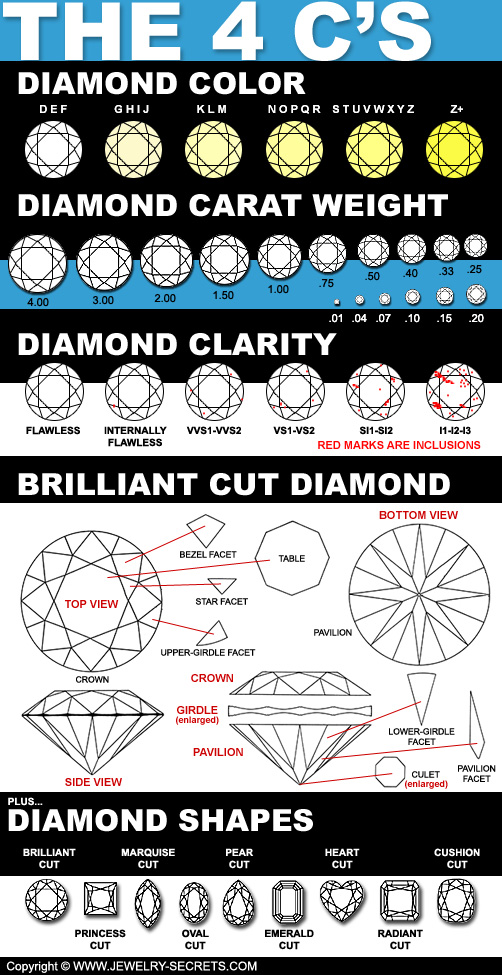
Carat Weight
Carat Weight is Simple. How Big of Stone are you Buying? 1/2 Carat? 3/4 Carat? 1.00 Carat?
Carats Break down just like Pennies to the Dollar. 1/2 Carat is 50 Points. 1 Full Carat is 1.00 Points.
1 Carats are the “Dream” Carat Weight! :)
But, the Actual Average Selling Diamond size is only 38 Points!

Color
Color is Simple as Well. Is your Diamond Pure White, Off White or does it have a Tinge of Yellow in it?
I Recommend a White Diamond like (G or H), but if you can, get a Pure White Diamond instead (D, E or F), because Pure White Diamonds are Very Bright and Very White!
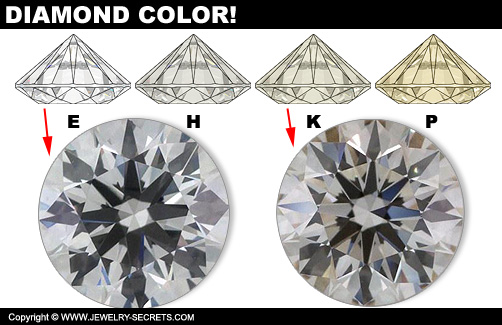
Clarity
Clarity is all about the Flaws and Imperfections in the Stone. And, actually it’s also the Placement, Size and Color of these Flaws that Determine the Clarity Grade given.
The Clarities Most Commonly Found on the Market are VVS, VS, SI and I Clarity.
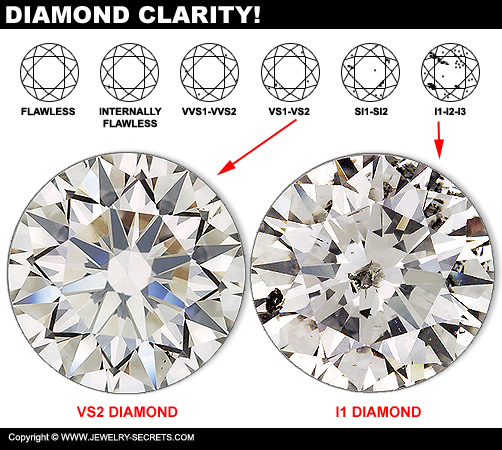
The Most Affordable Clarities are SI & I
Most People don’t Notice Inclusions in a Diamond unless they are really Big and Black. Then they Tend to Stick out like a Sore Thumb.
The Best Advice I can give is to Stick with a Diamond Clarity of at least SI1 or higher (if you want a Good Diamond). That way, the Inclusions (Birthmarks) in your Stone Remain Microscopic and WON’T be seen with the Naked Eye.
You have to Magnify them (with a Microscope or a 10x Jeweler’s Loupe)!
And that’s Good! :)
Cut
Cut Gets Trickier!
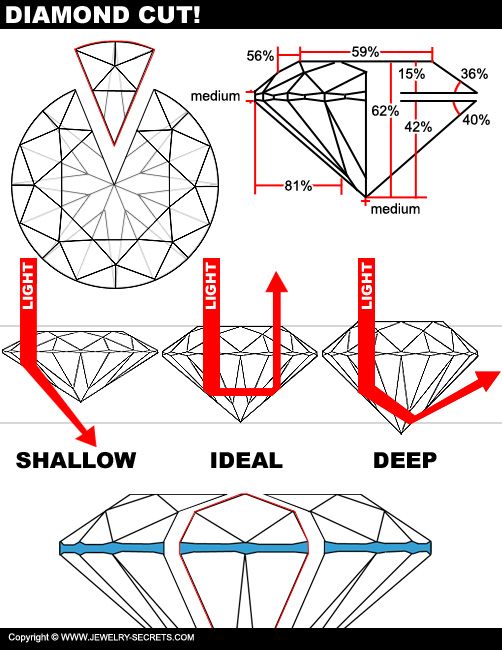
The good thing is, GIA made Cut so Easy with their Latest Improvements and Revisions to the 4C’s, that it only takes a Second to Determine if the Stone is Cut Well, or if it’s Poor!
You see, Cut used to be all about Numbers. It was Percentages, Proper Angles and Degrees, and it came across Pretty Complicated. It usually went right over Customer’s Heads.
You had to be a Mathematician to Grasp it all!
So GIA Developed NEW Cut Standards in 2005 that makes Cut so Much Easier for Customers, and Jewelers to Understand.
They did all the Hard Work for us.
GIA Classified every Angle, Proportion and Facet of a Diamond, as well as how Beautiful the Stone was and how much it Sparkled, and divided it into 5 Neat Little Categories:
- Excellent
- Very Good
- Good
- Fair
- Poor
Chances are Good you won’t see many Fair or Poor Stones on the Market (at least any Certified Stones). Most are Good or Higher!
The Higher you go up the Scale, the more your Diamond will Sparkle and Shine.
That’s why I Recommend a GIA Cut Grade of “Excellent”!
If you want the Brightest Stone, and the Most Brilliance, Fire and BLING, that’s the Cut to get!
So the only Reason why Diamonds are Scary and that you don’t know what you’re looking for, is because you haven’t Studied or Read about them.
I Can Help!
Read the Articles on my Jewelry Secrets Website here, and also take a Gander at the Diamond Guide Section that’s devoted to more detail about Diamonds and nothing but Diamonds.
And if you really want more, invest in my Diamond Course BEFORE you purchase your stone!
That will Help you Immensely.
4) Grade Bumping!
What the Heck is Grade Bumping?
It’s Bumping the Quality of the Stone up!
If a Stone is I1 Clarity, a Jeweler may Sell it as an SI2.
If a Color is H, a Jeweler could get away with Selling it as a G.
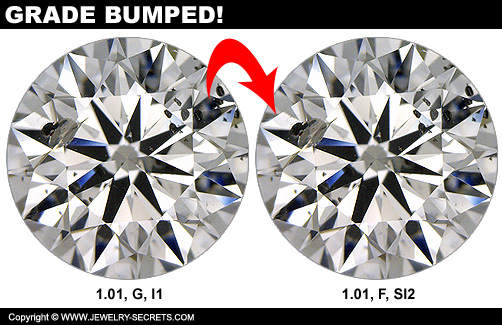
And You Know What?
This is Perfectly Legal and Legit!
And, it can happen to YOU!
The Reason Grade Bumping is Legal is because Grading Diamonds is Subjective and Opinionated.
Since every Diamond is Different and Unique, you can’t Easily Classify them all.
You could show a Diamond to Ten Different Professionals and possibly get back Numerous Results as to the Color and Clarity.
It’s all Based upon their Own Experiences, Talent, Mood and Opinion.
One Pro may call a Stone a VS2, another may say it’s only a SI1.
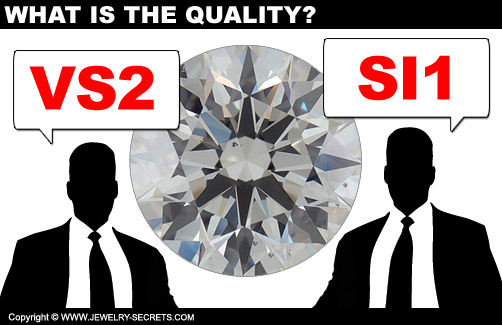
Who’s Right? Who’s Wrong?
No one!
It’s like trying to Classify Moles and Freckles on People. Good Luck There! It’s Impossible to say Exactly how many Inclusions a Diamond Clarity should have or how Big they are.
You also have to look at where they Fall in the Stone, what Color they are, and if the Flaws are Visible or Not.
And Yes, Size and Quantity are taken into Consideration as well, but sometimes a VS2 Diamond will have the Exact Same Number of Flaws as an SI1.
The Placement and Size may Alter, but you can’t really Pin it on one or the other.
In fact, an I Clarity Diamond really could have just 1 Inclusion, just like a VVS1 Diamond could. It’s all Speculative!
Color can be Difficult to Judge as well
Every Angle and Viewing Position of the Stone could show Slightly Different Body Tones and Hues.
So if one person says the Diamond is G, and another says it’s F, can you really say one person is more Accurate?
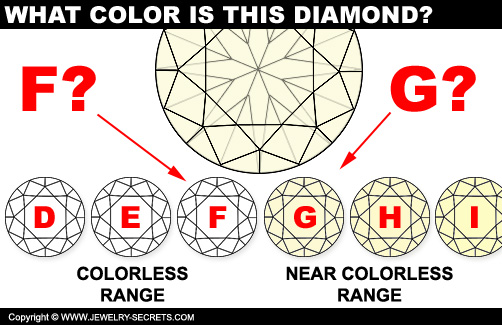
That’s why the FTC Allows Jewelers some Leeway when it comes to Grading. They have to. They allow Jewelers and Graders to be off by as much as One Full Grade.
So an SI2 could be Sold as an SI1.
A J Color could be Sold as an I.
It’s all Opinion.
How do you Protect Yourself?
By Buying GIA or AGS Certified Diamonds ONLY!
Buying Certified Stones will help you get the Quality of Stone you Wanted.
Buying Certified means that the Diamond is Graded by an Independent Laboratory, by Experience Professionals, and the Results are Accurate.
It basically means that you’re not just taking the Jeweler’s Word on what the Diamond is. It’s Backed up with Proof, and a Diamond Report.
And that’s Worth all the Money in the World!
That is… If you Buy the Right Certification!
Which leads me to #5…
5) All Certs are Not Created Equal
There are Thousands of Diamond Grading Companies in the Country.
The Main ones that you’ll see in Stores are: GIA, AGS, EGL, IGI, and HRD.
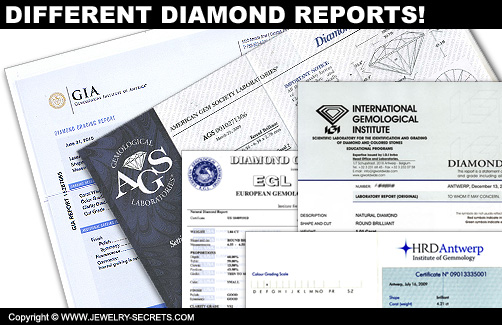
I, and many other Trusted Jewelers, will usually only Advise Buying 2 of them: GIA and AGS (As stated earlier).
I Recommend NO Others!
Other Diamond Reports (or Certificates as people call them), are Not Equal. The Standards are Not as Strict, the Lab not so High Tech, the Grading and Results are Not always so Accurate!
I’ve seen Diamonds Graded as SI1 that were clearly I Clarity, with Eye-Visible Inclusions!
Sometimes I’ll run across the other Reports doing Purchases and I’ll think to myself “What were they thinking?”
So as a customer, you may think that Buying a “Certified” VS1, G is a Great Stone. But if you send it to GIA to get it Tested and they Grade it as a VS2, H, then it doesn’t sound so Hot.
In Fact, the Difference in Price between 1 Carat Diamonds, one being a VS1, G, the other being a VS2, G, is Almost Staggering!
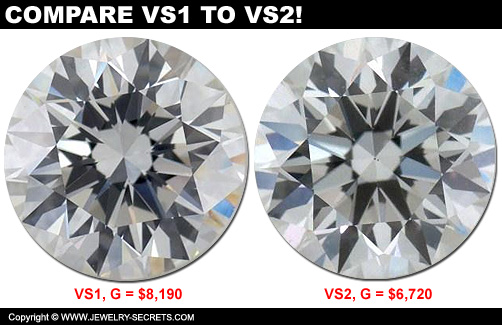
| CARAT WEIGHT, CLARITY, COLOR, CUT, CERTIFIED | PRICE | VIEW |
| 1.01, VS1, G, EXCELLENT, GIA | $8,190 | VIEW |
| 1.00, VS2, G, VERY GOOD, GIA | $6,720 | VIEW |
That’s a Price Difference of $1,470
That’s Huge Money to Lose!
Sure, there’s a Little Difference in Clarity and Cut. But, the only True Visible Difference you’d see is the Cash Leaving your Pocket!
Some Companies even Stray from GIA Standards and add in Extra Categories that GIA Doesn’t Acknowledge. You’ll find Stores selling SI3 Clarity Diamonds.
SI3 Diamonds are really just I1 Clarity Stones! By calling it an SI3, it makes them Sounds Better and Costs More!
Not Cool!
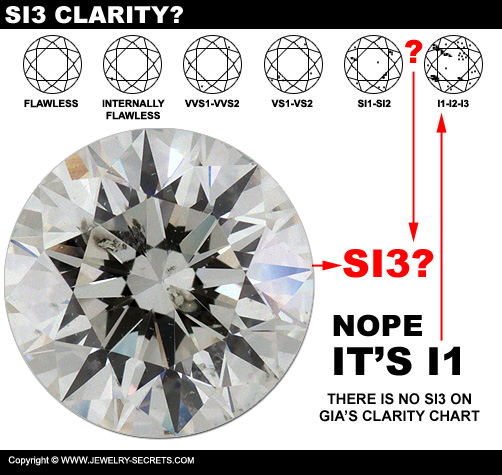
So Stick with the People that know Diamonds the Best. The people that Wrote the Book: GIA! (or AGS for a Very Close Second) :)
That way you won’t have to Worry about a thing! :)
6) Diamonds Aren’t Forever
Yes, I know, Diamond IS the Hardest Substance on Earth. Yes, I know, it’s been around for a Billion years.
And Yes…
That Diamond Could Chip or Break!
Once man gets Involved with the Whole Process, it Limits the Lifetime of a Diamond.
That’s because Man isn’t Perfect. Accidents Happen. And once you alter the Diamond Rough and Transform it into a Cut, Faceted, and Polished Stone, it makes it Vulnerable and Susceptible to Chipping or Breaking.
The Girdle is where a Diamond Chips the Most. Because the Girdle is the Weakest Part of the Diamond (it’s the Thinnest Section that comes to a Point).
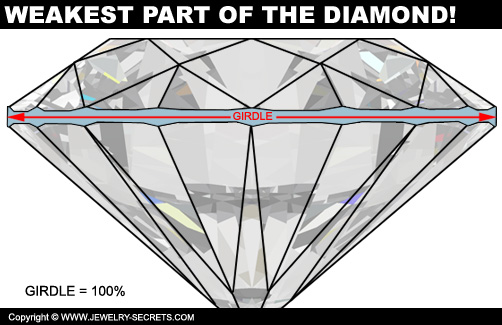
And, it’s also the Widest, Most Outer Most Circumference of the Diamond, so it takes a lot of Abuse. Whacking it. Hitting it. Bumping it…
And one Good Strike at just the Right Angle and the Right Amount of Force, Could Chip the Stone and Damage it Forever.
Prongs do a Good Job of Protecting the Stone, but things do happen in Life, and There are No Guarantees. Sometimes the Diamond does Crack!
Most people in their Lifetime will Never Chip or Crack a Stone, but some will, and it’s Not a Very Happy Situation.
Get your Diamond FULLY Insured, Just in Case!
That way, if you are one of the Unlucky Few People to Permanently Mar your Stone, you’ll be able to get it Replaced. WHEW!
7) Cut is Always Skipped over
9 times out of 10, when you go Shopping for Diamonds, the Salesperson will Dismiss CUT, and simply Refer to that 4C as the Shape of the Stone. As in:
“This is a Round Cut Stone!“
“This Diamond is a Marquise Cut“
This is what Most People think of when they think of Cut… The Shapes of a Diamond.
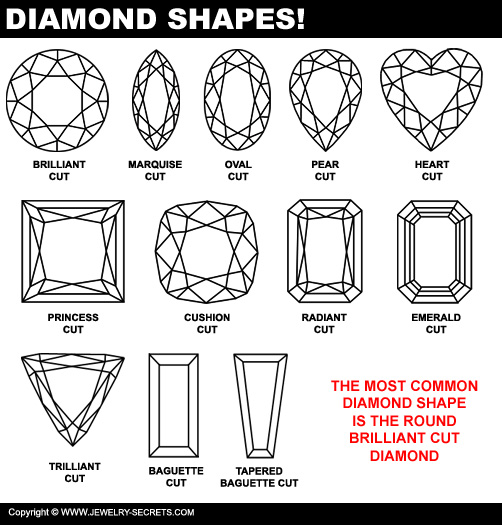
And sadly, that’s all the Customer will ever Learn about Cut.
That’s Not Enough info to go by.
Is it a Spread Stone?
Is the Diamond Losing Light?
Is the Stone Deep and Dark?
Is the Girdle so Thin it’s Easy to Chip?
You need to know these Kinds of Things.
So when you’re Looking at Diamonds, Please, I Highly Advise you to look at Certified Diamonds! And ALWAYS look at the CUT of the Stone!
You want to see Either: Excellent, or Very Good listed there!
That way you’ll know that the Stone isn’t Cut Too Shallow, or Too Deep.
Diamonds that are Off will Lose Light, Sparkle, Brilliance, Fire and Life!
Hence, the Diamond won’t be as Beautiful as the Next
Any Diamond, of any Clarity or Color, could have a not so Hot Cut to it. Will you know if you don’t look?
Compare Diamonds side by side and you’ll see that some VS1 Diamonds Sparkle MORE than other VS1 Diamonds. It’s all in the Proportions, Symmetry, Cut and Polish.
Look at a Diamond Report. You WANT to see EXCELLENT or VERY GOOD for all these Traits. Like so…
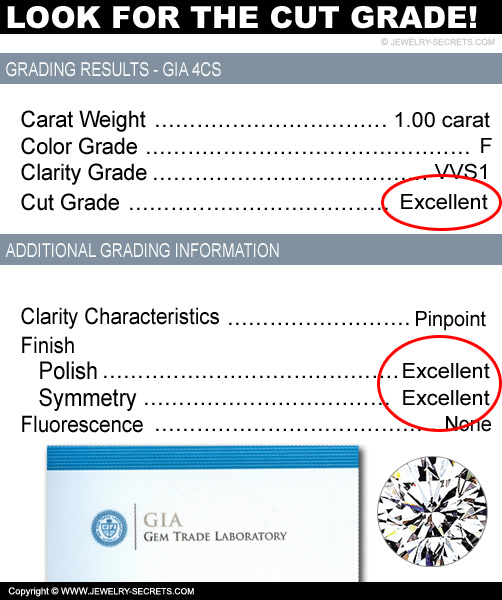
You should also Check the Girdle Thickness
The Thickness of the Girdle can be a Dead Giveaway as to How the Diamond is Cut.
If the Girdle has a Thickness of “Very Thick“, chances are, the Rest of the Stone will be Cut Lumpy and Thick as Well (a Poor Cut).
The very BEST Girdle Thickness to have are: Thin, Medium and Slightly Thick. See image below…
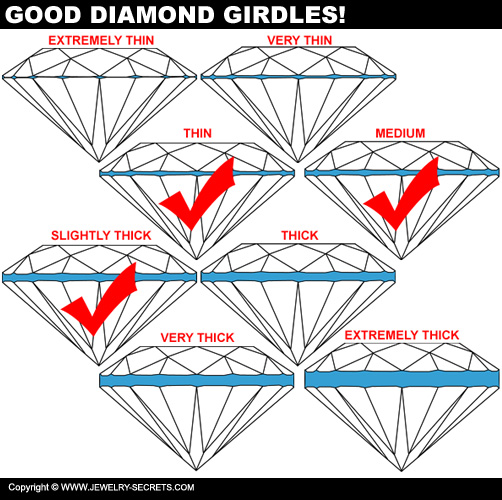
Out of all of them, I Prefer a Thin or Medium Girdle the Best. They are Not Too Thin and Not Too Thick. They don’t Take Away from the Beauty of the Stone. They make the Edge of the Stone more Durable. And they give the Prongs a Better Gripping Surface.
All in all, Cut is way more than just the Overall Shape of the Stone. It’s how the Facets are Proportioned and Angled. It’s how Light Interacts with the Stone. It’s how much the Stone Sparkles!
Cut is the MOST IMPORTANT 4C!
Read about Cut. Understand it. Or just look for Excellent or Very Good on the Diamond Reports. That’s the Easy Way Out. :)
8) What’s Fluorescence?
This is another Topic that many Salespeople Slide Past.
Hopefully, you WON’T!
Fluorescence is one of the many ways that could make one Diamond be Hundreds and Thousands of Dollars Less than another.
All things being Equal, if one Stone has a Strong Fluorescence, chances are it’ll be Cheaper.
Cheaper is Good, Right?
It can be. It may not be.
It all Depends on How the Fluorescence Affects the Appearance of the Stone.
So What is Fluorescence?
Take a peek…
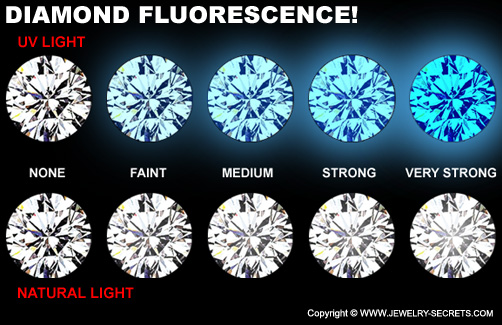
Fluorescence is when a Diamond has the Natural Ability to Glow-in-the-Dark! It Glows under UV Light, or Black Light.
Some Diamonds have it, others don’t. It also is one of the many Traits that Help Identify and Classify a Diamond (You’ll see Fluorescence listed on the Diamond Report).
Fluorescence may make a Diamond Look Great in Natural Light, just as Great as any other Stone. OR… it can also make it Look Milky, Cloudy, or Hazy. Even if that Stone has a High Clarity (like VVS1), and a very High Color (like E).
Fluorescence can, in some Instances, make a Diamond Dull, Foggy and Sparkle less.
That’s why some Stores will Sell these Stones Cheaper than the rest. They don’t Face up so Hot.
The Funny thing is, you won’t know exactly how the Diamond Reacts to Fluorescence Unless you View it with your own Eyes.
That’s the True Test!
That’s also why I say, Check to see if the Stone has Fluorescence. If it does, look at the Stone well in Different Lighting Atmospheres. See if it Hinders the Beauty and Sparkle.
If it does, SKIP IT!
In fact, it’s probably best to take the Safe Route and Skip all Stones with Fluorescence (especially Medium and Strong Fluorescence), Unless you Compare them side by side with Diamonds that don’t have Fluorescence.
The Stone may be Cheaper, but if it Lacks Sparkle and looks Cloudy, then Why Bother?
9) Multiple Colors & Clarity
Some Catalogs, Websites and Jewelry Stores will sell you a Stone that has Many Different Colors and Clarity.
WHAT?
Yep, they’ll list a Single Stone, say a 70 Point Diamond, with SI1-SI2 Clarity, and H-I-J Color. All for the Exact Same Price.
As so…
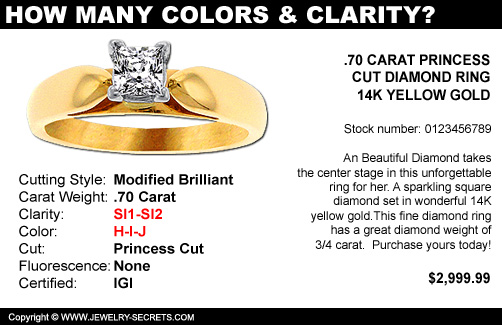
That’s Insane!
What is the True Quality of this Stone?
This Site is saying than a .70 Carat Diamond, SI1, H is the Same Price as an SI2, J?
I THINK NOT!
Let’s Compare these two Diamonds so you can see the Price Difference for yourself…

There’s a Price Difference of $980.00
Wouldn’t you like an Extra Grand in your Pocket?
So if you Purchase a Stone like this, that has Multiple Colors or Clarities listed, you won’t really know what the True Quality is of the Stone until you get it. It could be an I, it could be an H, it could be a J… Is the stone an SI1 or SI2? It all Matters!
I would bet, that if you Purchased the Stone in the example above, you would end up with the SI2, J.
And as you see, there’s a Big Difference in Price.
So if a Single Stone, One Diamond, is Shown with Multiple Colors or Clarities… RUN AWAY!!!
DON’T BUY IT!
A Single Diamond should ONLY have ONE Clarity and ONE Color!
Look at any Certificate from GIA or AGS. You’ll only see One Grade Listed. Not many!
You may think that you’re Buying an SI1, H… But if you end up with the SI2, J, then you may not be so Happy.
You’ll have Spent way More Money that you should have, and you will probably see Inclusions in the SI2 as well (that you wouldn’t see in an SI1).
That’s an Eye Opener!
So always buy Certified, and always make sure that your Stone has only one Clarity and one Color.
Really!
10) Approx. Carat Weights
You go to buy an Engagement Ring and the sales flier says that 1/2 Carat Diamonds are on sale for $1,295. Cool!
You Buy the Stone and when you get back home you Notice that the Appraisal says that the Diamond isn’t 1/2 Carat (50 Points), it’s only just 43 Points!
WHAT?
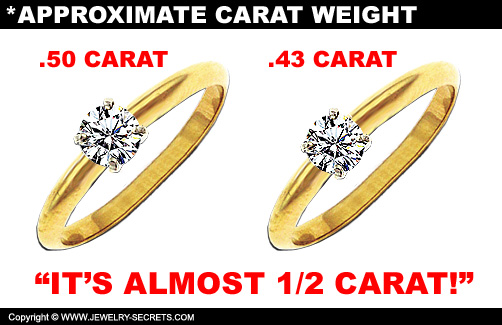
That’s because you didn’t Read the Sales Flier Good Enough. You Missed the Asterisks (*) on the end of 1/2 Carat. And if you look at the Fine Print at the Bottom of the Page or the Back of the Catalog, you’ll see that 1/2 Carat is an Approximate Carat Weight, and that Diamond could Vary anywhere from 43 Points to 57 Points.
That’s Crazy!
WHY?
It’s because it’s Very Difficult to get Diamonds of Exact Carat Weights (.25, .50, .75, 1.00). It all Depends on the Rough Parent Rock and how the Diamond was Proportioned.
Diamonds could be any Carat Weight: 42 Points, 52, 64, 102…
They’re like people when it comes to Weight. If you Weighed 100 people, How many people do you think you’d find that Weighed Exactly 150 Pounds? Not many!
One or two at the Most!
Diamonds are the same way. So when Jewelers Promote 1/2 Carat Diamonds, they will give those Diamonds a Range to Fall into. So yes, a 43 Point Diamond could be considered a 1/2 Carat Diamond.
FTC Approved!
The FTC knows this and so they allow a 7 Point Leeway one way or the other.
So if you truly want to buy a 1/2 Carat Diamond, check the Exact Carat Weight listed on the Actual Ring BEFORE you Buy it.
If it’s less than 50 Points, ask to see another Stone. Usually Stores carry Multiple Items that are listed in a Sales Catalog or Flier.
And if you do happen to get Lucky and get a Stone that is 57 Points instead… ENJOY IT!
You got more than you Bargained for! :)
11) Inclusions GROW!
You’ve been Wearing your Lovely little Diamond for 3 Months Now.
You Love it!
You look at it all the time.
But today, you happen to look down at your Stone and you see an Inclusion in the Stone that Wasn’t There Before.
That’s Because Inclusions Grow!
And… Actually I’m just Kidding!
Inclusions DON’T Grow!
They Can’t Grow. They have been the Exact Size ever since the Diamond was Created over a Billion Years ago.
So Why Do Inclusions “Suddenly” Appear?
Inclusions can seem to Appear for many reasons:
It could be that you Viewed your Stone in Different Lighting, or Brighter Light.
You could be Viewing your Stone from a Different Angle.
And… The Number One Reason why Inclusions Appear…
Because the Diamond is Dirty!
When your Diamond gets Dirty, especially underneath the Stone, the Diamond appears Dark and Doesn’t Sparkle so much.
When your Diamond Doesn’t Sparkle, it doesn’t Mask Inclusions very well. They become More Obvious and Stand Out.
The Remedy is Simple:
Clean Your Jewelry!
Clean them Good. Clean them Often!
It will make your Diamonds Sparkle. That Sparkle will Shine and Pretty Much Make your Visible Inclusions Disappear!
Easy As That!
12) The Appraisal and Retail is too High
Congrats! You just Bought a $12,000 for only $6,000.
It Sounds like a GREAT DEAL!
In fact, the Store even lists the Stone as $12,000 right on the Appraisal!
YOU WIN!
Umm, But Wait, Not So Fast!
When you Check the Prices of that Diamond Quality elsewhere, you’ll see that they sell a Similar Stone for $6,900.
So you may still have gotten a Better Deal, but Not Quite as Good as you thought.
It’s Not Worth $12,000!
Not only is it Not Worth $12,000, but it would Never Sell for $12,000. Ever!
The going Rate for a Stone like that is $6-7 G’s.
So why do some Stores Retail it so High and Jack the Price up?
To make it SEEM like a Much Better Deal.
1/2 off Sounds Much Better than 13% off, doesn’t it?
That “Steal” is a Little Exaggerated. So don’t always Believe the Higher Price Tag or Higher Appraisal.

Check Around
See what the Average Price is. That will tell you if the Deal is a Deal or Not.
Plus, an Over-Exaggerated and Inflated Appraisal Price only does one thing:
It Makes You Pay More Insurance!
You’ll Pay a More Premium Price for that High Priced Stone, and as you see, it’s Really Not Necessary.
Sure Tacking on a Little Extra for Inflation is Wise and Proper, but NOT Double the Price that you Pay.
That $6,000 Diamond should be Adjusted down to a Price and Appraisal Closer to $7,000 or $8,000.
That Way you Don’t Overpay!
It’s Just Not Worth it!
13) Diamond Warranty Void
A Diamond Warranty Sounds Really Good. After all, if you Lose or Crack your Stone, it will be Replaced for Free.
But…
Not Always!
Many times these Claims go Unpaid. The Reasons are Many:
- You Broke your Prong
- The Ring is Damaged
- You Missed your Cleaning and Inspection Date
The Point is:
Read the Fine Print on the Diamond Report. See what it does and does NOT Cover.
See what the Requirements are that you’ll Need to Uphold. And make sure you Adhere to them!
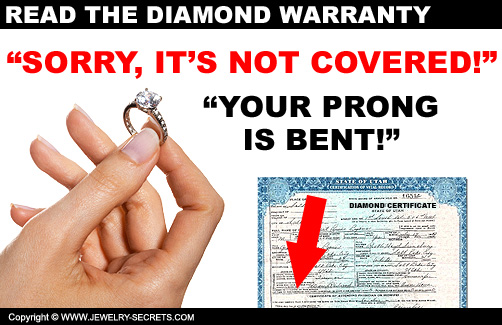
Otherwise, a Broken Stone Today could Cost you a Lot of Money Tomorrow!
My Recommendation:
I Recommend an Easier Fix: Get your Diamond Ring Fully Insured!
That way your Insurance Company not only will Pay if you Lose your Stone, but they’ll also Pay if your Whole Ring gets Stolen, Lost or Damaged Beyond Repair.
Check with your Insurance Provider to find out more.
14) Return Policies
“I’m Sorry, You Can’t Return It!“
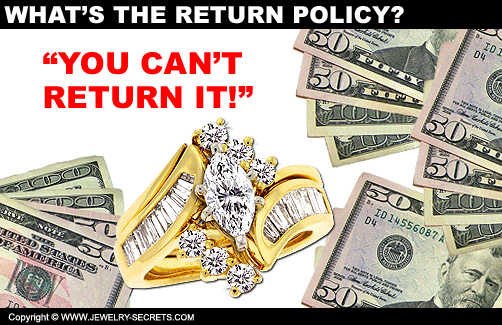
Guys Hear this a Lot! And for Good Reasons:
- The Return Time Limit Ran Out
- Your Ring is Damaged
- Your Ring has been Sized
- Your Ring has been Engraved
- You Custom Ordered it
I suggest that you Check with the Jeweler Before you Commit to Buy. What are the Rules and Policy for Returns?
Ask them…
How long do you have to Return it? Usually Stores offer anywhere from 3 Days to 3 Months.
Are there any Exceptions? Some items, like Clearance items and Blue Light Specials can’t be Returned! All Sales Are Final!
Is there a Restocking Fee? Many Stores do Charge a Fee for Returning the Ring.
Is it for Store Credit only? See if they will give you your Money Back, or if they just Issue you a Store Credit.
If they give you a 100% Full Money Back Guarantee, no Ifs, Ands, or Buts, then you know you’re Safe.
At least up until the Time Limit Runs Out.
Let’s Hope she says “YES” Quickly, and that she Keeps it! :)
15) Resell Value
Let’s say you Paid $8,000 for your Diamond Ring. You Don’t Want or Need it anymore. :(
You take it Back to the Jewelry Store that you Bought it from and they tell you that they can give you $1,500 for it.
OUCH!
Are you Kidding me?
NO!
That’s because Jewelers can Buy Diamonds at cost each and every Day of the Week. So why would they want to Pay More from you?
Seriously!
Plus, when they Buy Back your Items, they can’t just Stick them out in the Case and Resell them. Jewelers can only Sell Brand New Items (Unless they have a Special Section Dedicated for Antique, Estate or Pre-Owned Jewelry).
So what Jewelers have to do is to Break Apart your Rings. Remove all of the Stones and Gems (and Hope that they don’t Break them in the Process). Clean them, Weigh them, Sort them, Grade them… Just so they can Reuse them in other Mountings.
Then the Old Mounting, whatever it may be, Gets Scraped and Sent to a Refinery to Melt down, Purify and Redistribute.
It’s a Lot of Work! It Costs Time, Effort and Labor. And it could be Years before that Jeweler is able to actually Sell that Stone again.
This is why many Jewelers don’t “Buy Gold or Diamonds“.
The Going Rate?
Usually you’ll get about 10-20% of what you Paid for it (the Sale Price, not the Retail Price).
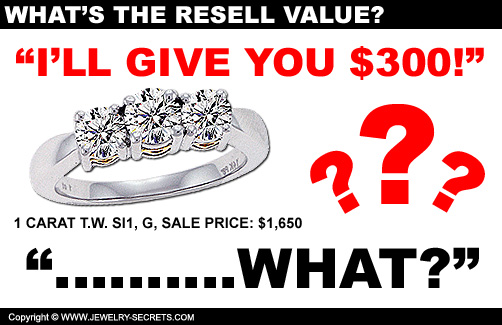
So yes, if you Paid $8,000 for a Diamond Engagement Ring (Appraised for $10,000), you could only get $1,600 for it. Or Less!
It all Depends on if the Jeweler has $1,600 available to Spend at the Time, and if they even Need or Want a Stone like yours. If they Don’t Sell that Quality, they may offer Less.
I will say, Single Diamond Solitaires of Good Carat Weight, Color and Clarity will generally…
Hold their Resell Value Better
Especially if it’s been Graded by GIA or AGS (And you Bring in the Certificate).
It’s sort of like a Car. Once you Drive it off the Lot, the Value Depreciates. It’s Now Considered “Used“.
And upon Selling it, of course, the Quality and Condition Matters the Most.
So don’t look at Diamonds as any Sort of Investment. Look at them as Awesome Masterpieces that will Remain on your Finger Forever.
P.S.
You will usually Get More for your Diamond if you Trade it Towards a Bigger and Better Diamond.
You did Want a 2.00 Carat Diamond, didn’t you?
Is that a Rip Off?
Hell No!
Cheers! :)



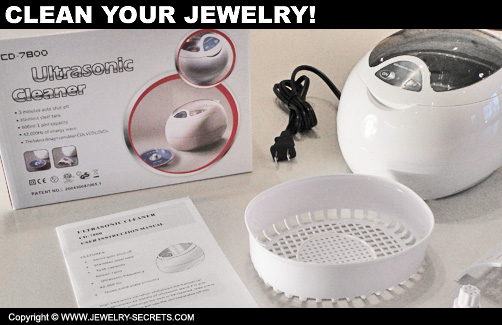












This article tries to justify the tip off. If you think I’m going to pay 10k for something with a resale value of less than 2k you are part of the problem. Here’s a thought, start a used diamond resale site. Instead of only getting 10-20 % back customers should sell to people looking for half the price in stores.
Hi Mary. Just trying to justify what some people think about diamonds and why. I would love to see a place that would buy back diamonds at even half their value, don’t know if it would be profitable or not, but it would be great to see. The same with cars and everything else we buy. Once they’re used, they depreciate. Plus, most stores will give 30% off bridal as it is, so the customer wouldn’t save much (at 50%), and they wouldn’t get any guarantees, nor warranties with the item. Kind of a hard sell. -Richard